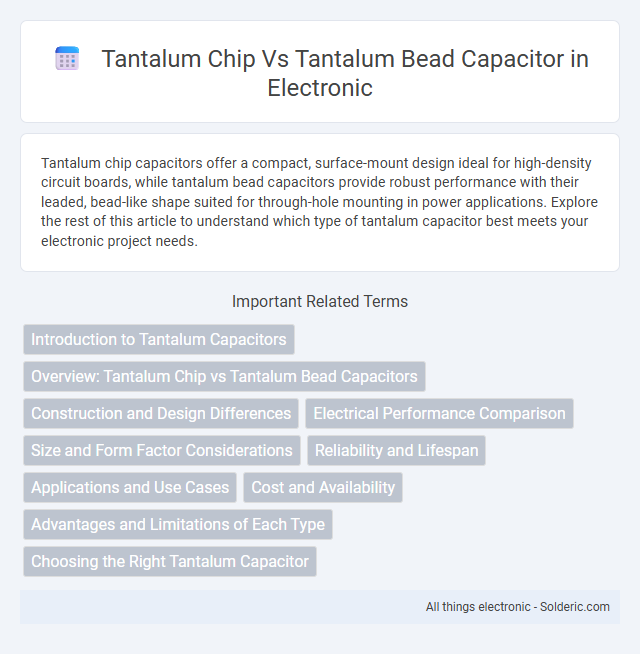Tantalum chip capacitors offer a compact, surface-mount design ideal for high-density circuit boards, while tantalum bead capacitors provide robust performance with their leaded, bead-like shape suited for through-hole mounting in power applications. Explore the rest of this article to understand which type of tantalum capacitor best meets your electronic project needs.
Comparison Table
| Feature | Tantalum Chip Capacitor | Tantalum Bead Capacitor |
|---|---|---|
| Packaging | Surface-mount device (SMD) | Axial leaded, bead-shaped |
| Size | Compact, low profile | Smaller diameter, longer length |
| Mounting Type | PCB surface mount | Through-hole leaded |
| Applications | High-density PCB, portable electronics | High-reliability, military, aerospace |
| Performance | Stable capacitance, low ESR | High surge current tolerance |
| Voltage Rating | Typically 4V to 50V | Typically up to 100V |
| Reliability | Good for commercial use | Superior, suited for harsh environments |
| Cost | Lower cost, mass production | Higher cost, specialized use |
Introduction to Tantalum Capacitors
Tantalum capacitors, including chip and bead types, utilize tantalum metal to achieve high capacitance in small volumes, making them ideal for compact electronic circuits. Tantalum chip capacitors feature a solid manganese dioxide or conductive polymer electrolyte, offering stable performance and reliable capacitance across a wide temperature range. Tantalum bead capacitors provide enhanced pulse-handling capabilities and lower equivalent series resistance (ESR), making them suitable for high-frequency filtering in RF applications.
Overview: Tantalum Chip vs Tantalum Bead Capacitors
Tantalum chip capacitors offer compact, surface-mount designs ideal for high-capacitance, low-voltage applications, while tantalum bead capacitors provide robust, through-hole construction suited for higher ripple currents and mechanical stress resistance. Your choice depends on factors like circuit space, voltage requirements, and environmental conditions. Tantalum chip capacitors excel in miniaturization and automated assembly, whereas tantalum bead capacitors are preferred for durability and performance in harsh environments.
Construction and Design Differences
Tantalum chip capacitors feature a flat, rectangular design with a solid manganese dioxide or polymer electrolyte layer directly on the tantalum anode, optimized for surface mounting on PCBs. Tantalum bead capacitors have a rounded, bead-like shape with a wire lead, constructed by dipping a tantalum pellet into electrolytic material, suited for through-hole mounting and often used in high-reliability applications. Your choice depends on the space constraints and mounting preferences, as chip capacitors offer compactness while bead capacitors provide robustness and higher surge current tolerance.
Electrical Performance Comparison
Tantalum chip capacitors offer lower equivalent series resistance (ESR) and higher capacitance stability over temperature compared to tantalum bead capacitors, making them ideal for high-frequency applications and sensitive electronic circuits. Tantalum bead capacitors exhibit superior surge current handling but typically have higher ESR and lower volumetric efficiency. Your choice depends on the specific electrical performance requirements, balancing low ESR and stability against robustness and surge capability.
Size and Form Factor Considerations
Tantalum chip capacitors offer a compact, rectangular surface-mount design that allows for higher capacitance in smaller footprints, ideal for space-constrained applications. In contrast, tantalum bead capacitors feature a cylindrical, axial form factor that typically occupies more board space but provides robust mechanical stability and ease of insertion in through-hole designs. Selecting between chip and bead variants depends on the specific size constraints and form factor requirements of the electronic assembly.
Reliability and Lifespan
Tantalum chip capacitors offer superior reliability with stable electrical performance and lower equivalent series resistance (ESR), resulting in longer operational lifespan under continuous high-stress conditions. Tantalum bead capacitors, while robust for high-frequency applications, generally exhibit shorter lifespans due to increased susceptibility to mechanical stress and higher leakage currents. Selecting between the two depends on application-specific demands for durability, thermal stability, and self-healing capabilities.
Applications and Use Cases
Tantalum chip capacitors are ideal for high-frequency applications such as RF circuits, mobile devices, and precision electronics due to their low ESR and compact surface-mount design. Tantalum bead capacitors excel in power supply filtering and energy storage in automotive, aerospace, and industrial systems where robustness and reliability under harsh conditions are critical. Your choice depends on specific application demands regarding size, frequency response, and environmental resilience.
Cost and Availability
Tantalum chip capacitors generally offer lower costs due to automated manufacturing processes and widespread use in high-volume electronics, making them more readily available than tantalum bead capacitors. Tantalum bead capacitors, with their hermetically sealed, hand-assembled design, tend to be more expensive and less common, often reserved for specialized applications requiring enhanced reliability. Supply chain factors also affect availability, with chip capacitors benefiting from larger production scales and broader distribution networks.
Advantages and Limitations of Each Type
Tantalum chip capacitors offer high capacitance in a small package, excellent frequency characteristics, and reliable performance at low voltages, making them ideal for compact electronic devices. Tantalum bead capacitors provide superior surge current handling and robustness against mechanical stress, suited for power supply filtering and military applications, but generally have lower capacitance values compared to chip types. Your choice depends on whether you prioritize size and frequency performance (chip) or durability and surge resilience (bead).
Choosing the Right Tantalum Capacitor
Selecting the right tantalum capacitor depends on the specific application requirements such as capacitance range, voltage rating, and physical size constraints. Tantalum chip capacitors offer compact size and stable performance, ideal for high-density circuit boards, while tantalum bead capacitors excel in low-profile designs with enhanced surge current handling. Evaluating factors like ESR (Equivalent Series Resistance), ripple current capability, and mounting type ensures optimal selection between tantalum chip and bead capacitors for reliable, long-term functionality.
Tantalum chip vs tantalum bead capacitor Infographic

 solderic.com
solderic.com